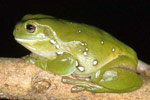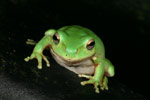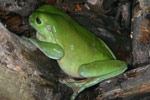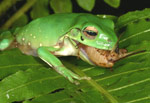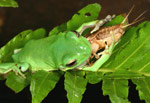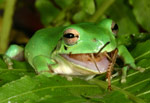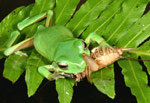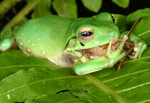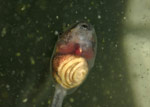Litoria caerulea
Green Tree Frog
Also: Common Green Tree Frog, Dunny Frog, Northern Green Tree Frog, White's Tree Frog

+ 47 kb Green Tree Frog (Litoria caerulea)
Distribution and habitat

Visible features
Presented here is the information stored in the frogs.org.au database which is used to identify frogs based on their appearance. It is intended to be used in a key guide for separating species so some of the information (for example, back colours) may be rather non-specific. The system is currently being developed - if you notice errors in the data, please write to Dave Black at the address at the bottom of the page.
Important note: This information details only the appearance of the frog. If an "or" appears in the description, this may mean either that there is some variation within the species or that the feature might be observed differently by different people. For example, if a frog has very small toe pads, it may be listed as having "Toe pads: present or absent".
Size
Up to greater than 90mm
Eyes, hands, and feet
Pupils: horizontal
Toe pads: present
Webbing on feet: half-webbing or full-webbing
Belly
Texture: smooth
Pattern: plain
Colour: single colour
Back
Texture: smooth
Pattern: plain or spotted
Colour: single colour
Glands and tubercles
Parotoid gland: present or absent
Tibial gland: absent
Metatarsal tubercles: keratinised glands present (black / brown) or absent
Litoria caerulea image gallery
The scientific names of Litoria caerulea
- Rana caerulea (White 1790)
- Rana austrasiae (Schneider 1799)
- Hyla cyanea (Daudin 1803)
- Rana coerulea (Daudin 1803)
- Hyla cyanea (Peron 1807)
- Hyla irrorata (De Vis 1884)
- Litoria caerulea (White 1790)

